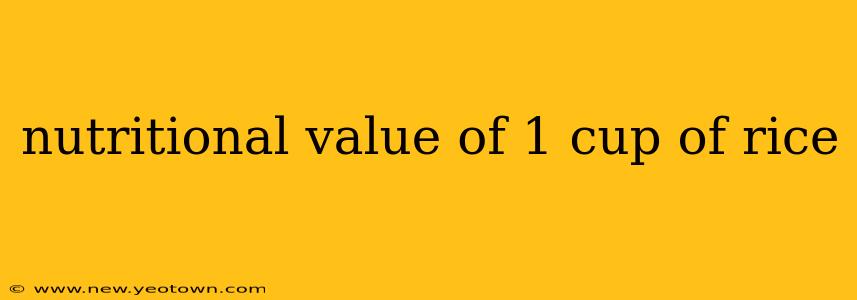The Surprising Nutritional Powerhouse: Unpacking the Value of One Cup of Rice
Rice, a staple food for billions worldwide, often gets unfairly relegated to the "simple carbohydrate" category. But a closer look reveals a more nuanced story—one filled with essential nutrients that contribute significantly to a balanced diet. Let's delve into the nutritional value packed into that seemingly humble cup of cooked rice.
One cup of cooked white rice typically contains around 200 calories. While it's true that this is predominantly from carbohydrates (around 45 grams), it's not a purely empty calorie source. Think of it as a readily available source of sustained energy, crucial for physical activity and cognitive function. But the story doesn't end there. This simple grain offers more than just energy.
What are the vitamins and minerals in 1 cup of rice?
One cup of cooked white rice provides a modest amount of several essential vitamins and minerals, though the quantities vary depending on the type of rice and its method of cultivation. Generally, you'll find small amounts of:
- Thiamine (Vitamin B1): Important for nerve function and energy metabolism.
- Riboflavin (Vitamin B2): Contributes to energy production and healthy skin.
- Niacin (Vitamin B3): Crucial for DNA repair and cell signaling.
- Iron: Essential for carrying oxygen throughout the body.
- Magnesium: Plays a role in muscle and nerve function, blood sugar control, and blood pressure regulation.
- Manganese: Important for bone health, wound healing, and metabolism.
It's important to note that these amounts are relatively small compared to other nutrient-rich foods. However, they contribute to the overall nutritional intake, especially when considered as part of a balanced diet.
Is brown rice more nutritious than white rice?
Yes, absolutely! Brown rice is undeniably the nutritional superstar of the rice family. Unlike white rice, which has had its bran and germ layers removed during processing, brown rice retains these nutrient-rich parts. This means a significantly higher concentration of:
- Fiber: Brown rice is a fantastic source of fiber, promoting digestive health and helping to regulate blood sugar levels. This is a key difference, as white rice is relatively low in fiber.
- Magnesium: Brown rice generally packs a higher amount of magnesium compared to white rice.
- Selenium: An antioxidant mineral that protects cells from damage.
- Manganese: Even higher concentrations than in white rice.
Consequently, brown rice offers a more complete nutritional profile and contributes more significantly to overall well-being.
Does the type of rice affect its nutritional value?
Yes, different types of rice boast varying nutritional compositions. Beyond white and brown rice, other varieties like wild rice, black rice, and red rice offer unique nutritional benefits, often containing higher levels of antioxidants and specific vitamins and minerals. Exploring these diverse options can add variety and nutritional depth to your diet.
How many calories are in 1 cup of cooked rice?
As mentioned earlier, a typical serving of cooked white rice (1 cup) contains roughly 200 calories. However, this can fluctuate slightly based on the type of rice and the cooking method. Brown rice tends to have slightly more calories per cup due to its higher fiber content.
Is rice good for weight loss?
Rice, particularly brown rice, can be part of a healthy weight loss plan. The fiber content in brown rice promotes satiety, helping you feel fuller for longer and potentially reducing overall calorie intake. However, portion control remains crucial. Overconsumption of any food, even healthy options like rice, can hinder weight loss efforts.
In conclusion, while a cup of rice might seem like a simple carbohydrate source, its nutritional value extends beyond just calories. Understanding the differences between various rice types and incorporating them wisely into a balanced diet can contribute positively to your overall health and well-being. Don't underestimate the power of this humble grain!

